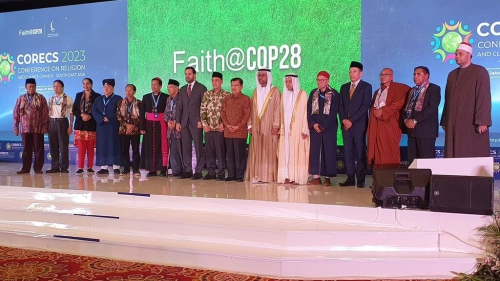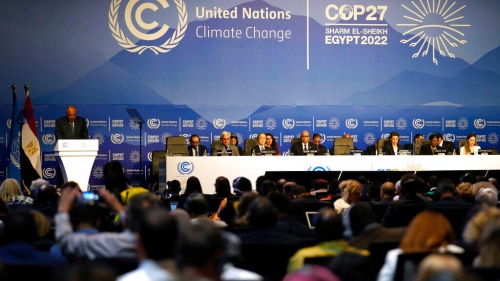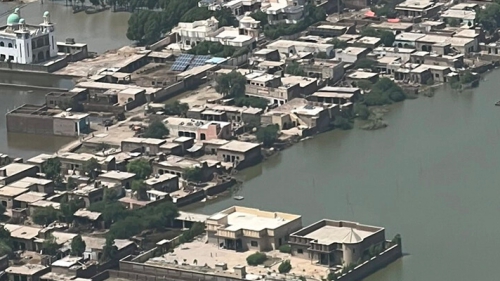Combatting Climate Change

Climate change or long-term shifts that occurred after the industrial revolution have brought about catastrophic changes in climate and have resulted in adverse consequences for human life and health on earth. Burning of fossil fuels like coal, oil and gas are among the major contributors of global temperature change.
Fossil fuel gases released in the atmosphere trap heat from the sun and act similar to the glass roof of a greenhouse and cover like a blanket result in rising of global temperatures. Among the major greenhouse gases associated with climate change are carbon dioxide, nitrous oxide, and methane.
The Intergovernmental Panel on Climate Change (IPCC), the leading international scientific body studying the subject established in 1988 by the world Meteorological Society and the United Nations Environment Program concluded that the concentration of these heat-trapping gases has increased substantially since preindustrial times to levels not seen at least for 800,000 years.
Carbon dioxide, the chief contributor to climate change, is up by 40 percent, nitrous oxide by 20 percent, and methane by a whopping 150 percent since 1750 – mainly from burning of dirty fossil fuels. Thus it is “extremely likely” that these emissions are mostly to blame for the rise in global temperature since the 1950s. And along with these, deforestation and degradation of forests have contributed significantly to global carbon emissions.
Global warming is caused by human actions and requires urgent attention
Hotter temperatures on land and sea alter global weather patterns changing how and where precipitation falls. These shifting patterns exacerbate occurrence of droughts, heat waves, floods, wildfires, and storms including hurricanes. They also result in melting office caps, glaciers and lead to rising sea levels, coastal erosions and declining biodiversity.
Climate studies indicate that it is humans who have caused and are responsible for global heating over the last 150 years. The average temperature on the earth’s surface is currently about 1.1 degrees Celsius warmer that it was before the industrial revolution, and rise in global temperature above 1.5 degree Celsius (34.7 degree Fahrenheit) are associated with catastrophic global impacts.
Climate change is impacting human lives and health in a variety of ways, and threatens the essential ingredients of good health, like clean air, safe drinking water, nutritious food supply and safe shelter, and has the potential to undermine decades of our progress in global health if we don’t act to control it.
Collective actions taken at the United Nations against rising temperatures: Limiting the rise in global temperature
The UN established an international environmental treaty to combat human interference with climate called UN Framework Convention on Climate Change (UNFCCC). It was open for signatures at a conference in Rio de Janeiro from June 4 to June 14 1992 and adopted at the UN headquarters in New York on May 9, 1992.
The treaty was enforced on March 21, 1994 and received 166 signatures. It has now signed by 198 countries and has called for regular meetings of the Conference of the Parties (COP) to review implementation and check progress on climate change treaties and proceed to work accordingly for a sustainable universe.
The ultimate objective of all agreements under UNFCCC is to stabilize greenhouse gas concentrations in the atmosphere at a level that will prevent dangerous human interference with the climate system, in a time frame which allows ecosystems to adapt naturally and enables sustainable development.
The UN Climate implementation to limit greenhouse gas emissions
The Kyoto Protocol committed the developed countries to limit emission reductions
The Kyoto Protocol was the first UN climate implementation adopted on December 11, 1997, enforced on February 16, 2005 and it committed the industrialized countries and economies in transition to limit and reduce greenhouse gases emissions to accord with agreed upon their individual targets. It only considered the developed countries and placed a heavier burden on them under the principle of “common good but differentiated responsibility and respective capabilities”, because it recognized that they were largely responsible for the current high levels of greenhouse emissions in the atmosphere. The Kyoto Protocol set binding emission reduction target for 37 industrialized countries and economies in transition of the European Union. Overall, these targets added up to an average 5 percent emission reduction compared to 1990 levels over the five year period from 2008 to 2012.
The Landmark Paris Agreement binding all nations to combat climate change
The Kyoto Protocol was superseded by the Paris Agreement and adopted by 196 parties at the Climate Change Conference (COP) in Paris on December 12, 2015. The treaty was enforced on November 4, 2016 with the goal to hold “the increase in the global average temperature to well below 2 degrees Celsius above pre-industrial levels” and pursue efforts “to limit the temperature increase to 1.5 degrees Celsius relative to the pre-industrial levels.” However, in recent years world leaders stressed the need to limit global warming to 1.5 degrees Celsius by the end of 2000.
The Paris Agreement is a landmark multilateral climate change process because for the first time it requires a binding agreement to bring all nations together to combat climate change and adapt relevant measures to control its dangerous effects. Its implementation requires economic and social transformation, based on the best available science and it works on a five-year cycle of increasingly ambitious climate action carried out by the individual countries. Since 2020 countries have been submitting their national climate action plans known as nationally determined contributions (NDCs).
Each successive NDC is meant to reflect an increasingly higher degree of ambition compared to the previous one. Recognizing that accelerated action is required to limit global warming to 1.5 degrees Celsius, the COP 27 meeting in Egypt requested parties to revisit and strengthen the 2030 targets in their NDCs to align with the Paris Agreement temperature goal by the end of 2023 by taking into account their national circumstances.
The countries communicate in their NDCs actions they take to reduce their greenhouse gas emissions in order to reach the goals of the Paris Agreement, and actions taken to adapt to impacts of climate change.
The U.S. as the top carbon emitters provides financial assistance to the vulnerable
The Paris Agreement reaffirms that developed countries should take the lead in providing financial assistance to countries that are less developed and more vulnerable. For the first time it also encourages voluntary contributions by developing countries.
Climate finance is needed for mitigation because large-scale investments are required to significantly reduce emissions. As well as work to adapt to reduce the adverse impacts of a changing climate. The U.S. along with the E.U. and China account for 60 percent of world GDP and are the world’s top carbon emitters emitting nearly half of the world’s greenhouse gases, and need to bear greater responsibility to mitigate the global carbon print. But the U.S. and Europe have historically resisted measures that might hold them liable for the costs of their emissions, while China and India have resisted demands to phase out of coal.
While U.S. President Donald Trump withdrew from the Paris Agreement, thousands of leaders continued to participate as mandated, President Joe Biden rejoined it and has dramatically increased U.S. funding of international Climate Finance since taking office from $1.5 billion in 2021 to $5.8 billion in 2022 and is on track to account $9.5 billion in 2023.
The recent UN COP 28 Climate Change Conference held in Dubai: achievements and shortcomings World leaders, government representatives and delegates of relevant organizations gathered for the annual United Nations climate change conference, the COP 28 in Dubai’s Expo City at the United Arab Emirates from November 30 to December 12, 2023. There were 52,000 party delegates and 90,000 non-party delegates participating in this COP 28 conference.
Objections to holding COP 28 at UAE and Al Jaber as the COP President
The Time December 4, 2023 ran a cover story by Justin Worland titled Sultan Al Jaber, Man in the Middle, the oil executive at the center of a global climate fight. Al Jaber is the Abu Dhabi National Oil Company CEO, also president of the COP 28. UAE has 100 billion of proven oil reserves ranking six worldwide, and ADNOC plans to invest more than $150 billion on growth projects that will expand its crude-oil production to 5 million barrels per day by 2030. As such more than 100 members of the European Parliament and the U.S.
Congress declared that Al Jaber “severely jeopardized” the COP process and called on him to resign. And Al Gore the Nobel laureate and advocate of the Climate Reality Project said of Al Jaber, “He is a nice guy. He’s a smart guy. But a conflict of interest is a conflict of interest.”
Al Jaber responds: his approach based on “realism”
In contrast to the above, Worland noted Al Jaber’s oil rigs now run on electricity, with digital tools allowing the company to map where energy is wasted. And the company has begun building big-budget carbon-capturing projects. Worland said, “As a COP28 chief, he has called on other oil companies to come to Dubai with similar commitments to crack down on leaks of methane, a potent greenhouse gas, and to decarbonize their own operations.”
The Time article noted Al Jaber described his approach based on “realism.” Al Jaber said “Oil is in high demand, and even in the most aggressive decarbonization scenarios, we will still need some supply by the middle of the century. “ “It’s best that whatever oil we use has the lowest carbon content available. That’s especially important in the UAE and Saudi Arabia, where oil is so cheap that it will likely remain in the global energy mix longer than oil from anywhere else”, he said.
Oil companies pledge to lower methane emissions at COP 28
In confirmation, Al Jazeera December 2, 2023 reported, “Fifty oil companies representing nearly half of global production have pledged to reach near-zero methane emissions and end routine flaring in their operations by 2030.” The pledge was given by major national oil companies such as Saudi Aramco, Brazil’s Petrobras and Sonangol from Angola and multinationals like Shell, Total Energies and BP.
UN fund for loss and damage established for developing countries affected by climate change
Another major achievement reached by the global COP 28 climate summit in Dubai reached a breakthrough agreement that established a U.N. fund for loss and damage for developing countries affected by climate change. The fund remained a key demand of developing nations for nearly 30 years, called for immediate establishment during the COP 27 summit in Egypt in 2022.
The unprecedented floods of 2022 in Pakistan and coincidental chairmanship of G77 group allowed developing nations to lobby extensively for the fund. The fund will funnel voluntary contributions from developed countries to low and middle-income nations struggling to cope with billions of dollars in damages from climate- exacerbating drought, extreme weather and sea-level rise. Antonio Guterres, the U. N. Secretary general applauded the agreement and called on leaders to make generous contributions to help establish the fund.
Following announcement of the fund at the opening ceremony, the United Arab Emirates pledged $100 million, Canada $16 million, France $100 million, Japan $10 million, and the European Union promised $245 million (including $100 million from Germany). The U.S. pledged $17.5 million – considered a drop in the bucket by climate advocates.
Record Funding for Green Climate at the COP 28
On December 2, 2023 a number of dignitaries came out to fund the World Climate Action summit where governments, development banks and companies announced initiatives to mobilize billions to invest in renewable energy souces. UAE unveiled $30 billion for a new climate investment venture.
Named ALTRRA, it aims to mobilize $250 billion in investment by the end of decade, for what COP28 President Sultan Ahmed Al-Jaber described as a “defining moment “for green climate finance. He called it “the world’s largest private investment vehicle for climate change action” and included $5 billion allocated for poorer countries. The World Bank promised to increase the amount it spends annually on climate-related projects to 45 percent of its financing in 2024-25, up from 35pc now as part of policy overhaul to better respond to climate change.
The Green Climate Fund received a boost with the announcement of six new pledges. Australia, Estonia, Italy, Portugal, Switzerland and the United States of America pledged new funding at COP28.
Commitment to transition away from fossil fuels at COP 28
The COP conference was extended by a day as the participants struggled over the agreement on how quickly fossil fuel production should be ceased. While more than 100 countries supported “phasing out” fossil fuels or putting a complete stop to burning of fossil fuels through goals such as net-zero carbon emissions by a specific year, the final draft called for “transitioning away from fossil fuels in energy systems, in a just, orderly and equitable manner, accelerating action in this critical decade.”
That transition would in a way get the world to net zero greenhouse gas emissions in 2050. The final version explicitly called on all nations to contribute to reduction in greenhouse gas emissions through a series of actions, as reported by Al Jazeera on December 13, 2023.
Reducing greenhouse gas emissions and burning fossil fuels to avert catastrophic climate change
According to IPCC climate change will be limited only by “substantial and sustained reduction in greenhouse emissions.” The general scientific view represented by the October 8, 2018 “IPCC’s Special Report: Global Warming at 1.5 degrees Celsius” that any rise in global temperatures of more than 1.5 degrees Celsius would be an unacceptably high risk, potentially resulting in major extinctions, more severe droughts and hurricanes, a watery Artic, and increased toll on human health and well-being.
Furthermore, as IPCC noted, while it remains uncertain precisely how much global warming will “ trigger abrupt and irreversible changes” in the earth’s systems, the risk of crossing the threshold only increases as temperatures rise. In 2023 the IPCC gave the “final warning” on climate apocalypse and reported that the world could surpass the point of catastrophic warming in the next decade unless it immediately stops guzzling fossil fuels.
UN Secretary General Antonio Guterres told world leaders that burning of fossil fuels must be stopped outright and a reduction or abatement in their use would not be enough to stop global warming. “We cannot save a burning planet with a fire hose of fossil fuels,” he said. “The 1.5 degree limit is only possible if we ultimately stop burning all fossil fuels. Not reduce. Not abate.”
Guterres urged fossil fuel companies to invest in a transition to renewable energy sources and told governments to help by forcing that change – including through the use of windfall taxes on industry profits. “I urge governments to help industry make the right choice by regulating, legislating, putting a fair price on carbon, ending fossil fuel subsidies, and adopting a windfall tax on profits.”
Addressing the world leaders, Guterres asserted climate justice was long overdue and developing countries were being devastated by disasters they did not cause. “Extortionate borrowing costs are blocking their climate action plans and support is far too little, far too late.” He went on to say that the climate challenge was not just another “issue to the inbox “but protecting the climate was the world’s “greatest test of leadership.”
According to a September 14, 2023 report by Reuters global investment of $2.7 trillion a year is needed to achieve net zero emissions by 2025 and avoid temperatures from rising above 1.5 degrees Celsius this century.
Scientists have said the world ideally needs to limit global average rise to 1.5 C this century to avoid catastrophic effects from climate change. Many governments have pledged to reduce emissions to zero by mid-century to help achieve this. However, most countries are not on track to even meet emission targets by 2030, let alone 2050. Net Zero refers to cutting emissions to as close to zero as possible with any remaining emissions re-absorbed from the atmosphere, by oceans and forests, for example.
Solutions for averting adverse climate change through individual and collective actions
Thinking about climate change can be overwhelming and we have been aware of its causes for decades. The good news is that we know what it will take to win the fight against climate change. The following is generalized version of major considerations by the Natural Resources Defense Council dated December 13, 2022.
1. Ending reliance on fossil fuels. The single-most important thing is to end our reliance on fossil fuels, which is responsible for more than 75 percent warming our planet. We must replace coal, oil and gas with renewable and efficient energy resources such as electric generated by sun, wind, and water. Each passing year, clean energy is making gains as our technology improves and production costs go down.
2. Greater energy efficiency. Energy efficiency has been referred to as “the first fuel.” More energy efficient our production systems are, the less actual fuel we will consume. By employing climate friendly strategies, we can help utility companies adopt performance-based regulation systems, and improve the services they provide. Others strategies could be extraordinarily simple such as replacing light bulbs from incandescent to LED can make a big dent in our energy consumption.
3. Sustainable transportation. Transportation is a top source of greenhouse gases. Therefore eliminating pollution from billions of vehicles driving across the planet is essential to achieve net-zero global emission by 2050, a goal in the 2015 Paris Climate Agreement.
4. Sustainable buildings. The energy used in our buildings makes them the single-largest source of carbon pollution. Making them more energy efficient, such as upgrading widows and adding insulation to attics and walls will bring them in conformity with what is required. Therefore, it is important to raise public awareness to cost and carbon saving changes that individuals can make in their homes and workplaces by purchasing and installing energy-efficient instruments such as heat pumps. Beyond individuals, we can have businesses and governments take measures for decarbonizing and requiring building codes to install clean-powered appliances.
5. Better Forestry and agriculture management. Our strongest allies in the fight against climate change are trees, plants that release oxygen for our use and store massive amounts of carbon at ground level or underground. Without these carbon sinks, life on earth would be impossible with atmospheric temperatures rising to unbearable levels. Also widespread overuse of nitrogen-based fertilizers on cropland and industrial livestock farming release unprecedented amounts of nitrous oxide and methane into the atmosphere. We need a combination of responsible forestry, and create international pressure and changes in our consumer behavior to end deforestation and adopt practices with organic and regenerative agriculture such as cover crops, pesticide use reduction, rotational grazing and use of compost to help nurture the soil, and pay climate dividends.
6. Conservation-based solutions. Intact ecosystems suck up and store vast amounts of carbon. Coastal systems like wetlands and mangrove accumulate and store carbon in their roots, our forests soak up about a third of annual fossil emissions, and freshwater wetlands hold between 20 to 30 percent of all the carbon in world’s soil. That is one reason why climate experts are calling on global leaders to fully protect and restore at least 30 percent of land, inland waters, and oceans by 2030.
7. Industrial solutions. Heavy industry is responsible for 40 percent of greenhouse gas emissions globally. Most industrial emissions come from making small carbon-intensive products. Starting investments in decarbonized industrial processes should sharply reduce heavy industry’s climate emissions, and less developed nations could adopt these cleaner processes without increasing emissions and bolster their manufacturing.
8. Technological solutions. Technology alone would not save us from climate change, but we could use technology by researching and developing things like longer-lasting EV batteries, nonpolluting solutions for capturing and sequestering carbon. We should make sure not to repeat past mistakes and act to reduce harm from mining lithium, and improve recycling of solar cells. Funding is critical for this, and we could approach governments to invest in clean energy technology as a priority and spur innovation through grants and other rewards.
9. Choices we make. It is important to think of the choices we make daily in our lives. We, as individuals, should be involved in lobbying our legislators, and speak up in our communities, but also take climate actions in our daily lives by switching off fossil fuels in our homes and being more mindful of the climate footprint of the food we eat, our shopping habits, how we get around, our use of plastics, and what businesses we choose to support (or not support). But it is when we act collectively that real change happens.
Thus we can do more than cut down on carbon pollution. Winning could start locally to protect the right to do more for clean air and clean water for everyone. The real change could happen in cutting down carbon pollution, act responsibly in making our choices and consider implications of our actions.
Topics: Climate Change, Cop28, Earth
Views: 510
Related Suggestions

















